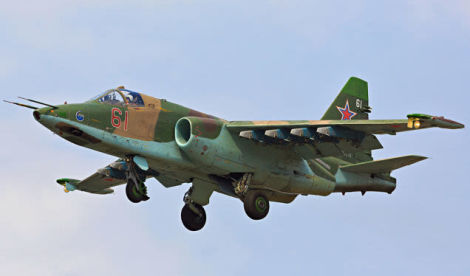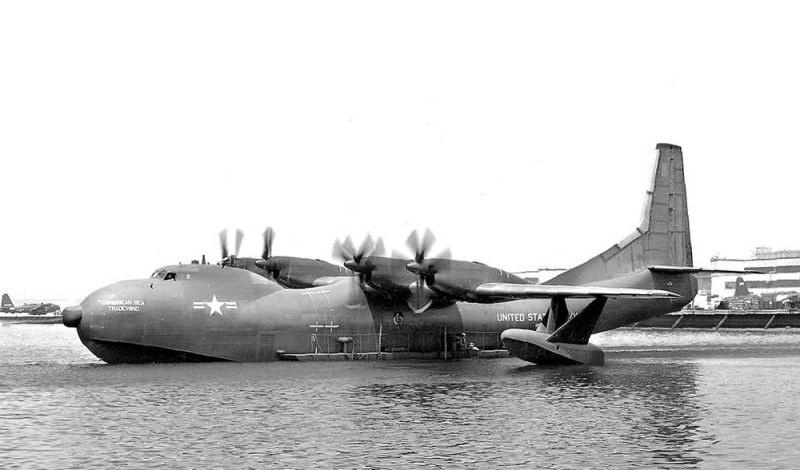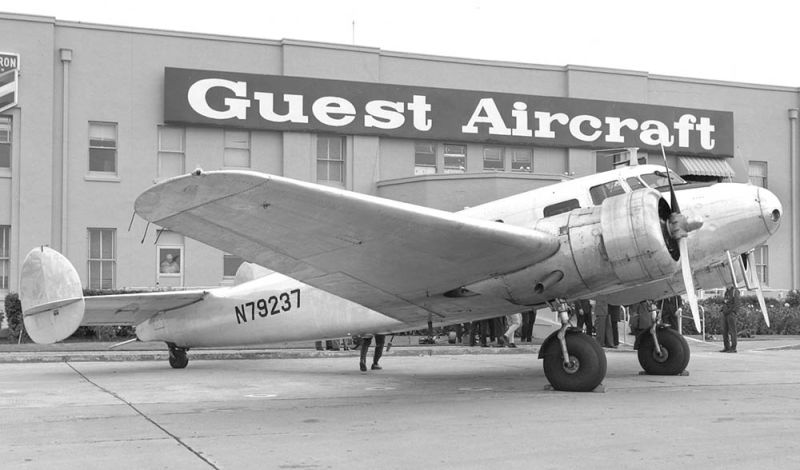Welcome to This Date in Aviation History, getting of you caught up on milestones, important historical events and people in aviation from February 22 through February 25.

February 22, 1987 – The first flight of the Airbus A320. By the mid-1960s, the international airliner industry was dominated by American companies Boeing, McDonnell Douglas and Lockheed. European manufacturers had developed some innovative aircraft, but production runs were small, and there was no sign of European companies making a significant entry into the airliner market. But by the end of the decade, airliner manufacturers in France, England and West Germany, with critical government backing, dedicated themselves to challenging American dominance, and Airbus Industrie was formed in 1970. (The name Airbus is a generic term for an airliner, and it was first coined by Hawker Siddeley in 1959 for a passenger version of the Armstrong Whitworth AW.660 Argosy.)

The first aircraft to come out of the partnership was the A300, which took its maiden flight in 1972. The A300 was the world’s first twin-engined widebody airliner and seated up to 266 passengers. But with relatively slow sales, it was clear that the burgeoning European airliner industry required a smaller, short- to medium-range airliner with reduced seating capacity to feed passengers into larger airports as part of a hub-and-spoke system. Airbus began work on a new airliner that could compete directly with the widely popular Boeing 737 and McDonnell Douglas DC-9.
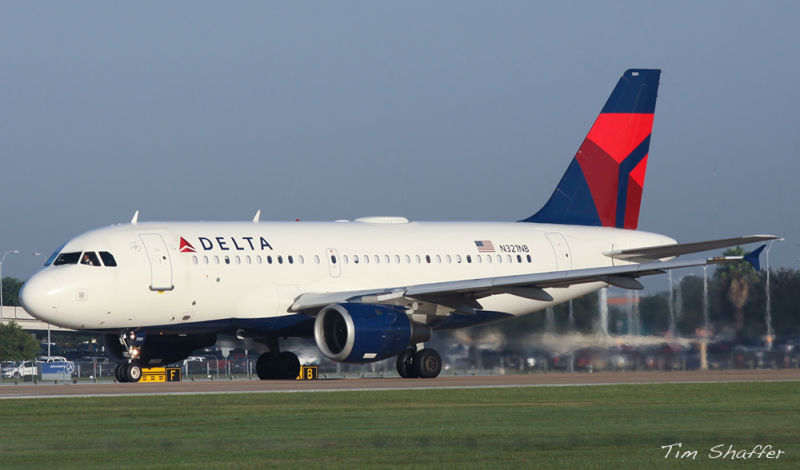
After considering a myriad of different configurations, Airbus focused on an airliner powered by a pair of efficient CFM International high-bypass turbofan engines and targeted at the 125- to 180-seat market. But the company didn’t have their sights set on a single airliner. They envisioned a family of three separate narrow-body, single-aisle airliners. The first to be developed was dubbed the A320. With accommodations for 150 passengers, it was the midsize airliner in the family and had a range of 3,280 miles. Looking at the competition, Airbus designed the A320 to be just under one foot wider than the Boeing 707 and 727 to increase its chances of competing successfully with the 737. The A320’s overall shape was also more aerodynamically efficient than the 737 and McDonnell Douglas MD-80, and also slightly faster. At its launch, the A320 was one of the world’s most advanced airliners and the first to employ digital fly-by-wire technology, something that had up to that time been been reserved for military aircraft. In another nod to military aircraft design, the A320 traded the traditional pilot’s yoke for a side joystick control.
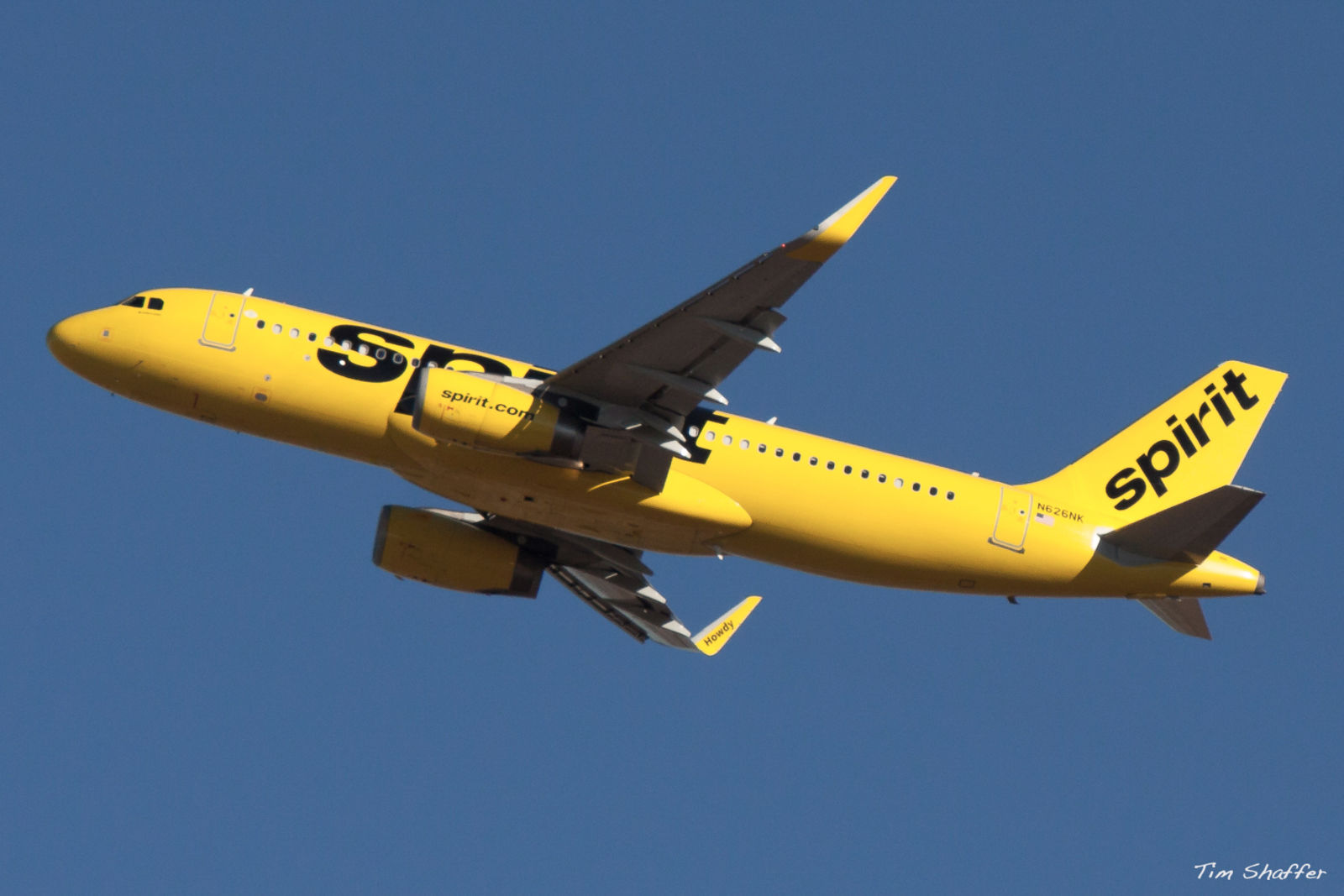
When the first A320 was rolled out of the final assembly facility in Toulouse, France on February 14, 1987, Airbus already had more than 400 orders on the books before the first aircraft even took to the skies. Air France took delivery of the first A320 on March 26, 1988, and the airliner entered service soon after. With the launch of the A320, Airbus had firmly solidified its position as a major, world-class developer of commercial airliners.

Adhering to the original plan, the A320 was subsequently stretched into the A321 with accommodations for up to 236 passengers in a single-class configuration, and then shortened into the A319 and the A318, with capacity for 156 and 132 passengers respectively. Further developments include the A320neo (new engine option) with more efficient engines and the addition of blended winglets (called Sharklets by Airbus) which increase range and decrease fuel consumption by as much as four percent. The Sharklets were then retrofitted to older airliners. In February 0f 2018, Airbus completed the 8,000th airliner of the A320 family an have added more than 600 more since then, and the the airliner is in service with more than 330 airlines worldwide.

February 24, 1940 – The first flight of the Hawker Typhoon. The Hawker Hurricane was a 1930s-era fighter design that fought with great effectiveness throughout the war, and one of two British fighters that beame a symbol of the Battle of Britain. Though it wasn’t able to tussle with the high-flying German fighters, it proved quite effective against low-flying German bombers. The Hurricane took its maiden flight in 1935, but even before it entered production in 1937, Hawker and famed engineer Sydney Camm, who had designed the Hurricane, had already begun work on a more powerful successor.

Camm worked with two basic designs, both bearing a family resemblance to the Hurricane, though somewhat larger. One reason for the increase in size was to accommodate a massive engine, the Napier Sabre. The Sabre produced up to 3,500 hp in its later versions, and would become one of the most powerful inline piston engines in the world. By 1938, Hawker was ready to proceed with the development of a prototype following the receipt of Air Ministry Specification F.18/37 which called for a fighter with a top speed of at least 400 mph at 15,000 feet using a British-built engine, and accommodations for no fewer than twelve .303 Browning machine guns.

Not only did the Typhoon bear an outward resemblance to the Hurricane, it shared many of the same construction techniques of its predecessor, including a relatively thick wing. While the wing provided excellent strength, its thickness led to significant drag at high speeds, and also affected high altitude performance and climb rate. All of this resulted in a fighter that was ultimately unable to counter the high-flying German Focke-Wulf Fw 190. Therefore, the mission of the Typhoon changed from that of a high-altitude interceptor to a low-level interceptor, a switch which played to the strengths of the Typhoon. Like the Hurricane before it, the Typhoon became a specialized bomber killer, flying high enough to attack the bombers from above, and having the speed and hitting power to knock them out of the sky.

As the war in Europe progressed, the Typhoon matured as well, and truly became a work in progress. As the needs of the RAF changed, the Typhoon changed with it, and many new features and redesigns made their way into production, or as retrofits in the field. The original solid cockpit with side door and cranking window gave way first to a clear canopy with added rearward visibility, then to a bubble canopy. The 12 machine guns gave way to four 20mm cannons, and provisions were made to carry greater external loads. Having proven itself an effective interceptor, the Typhoon found its true calling as a devastating ground attack aircraft, one of the most potent of WWII. Already deadly with its cannons, the Typhoon was capable of carrying two 1,000 pound bombs, earning it the nickname “Bombphoon.” The addition of rockets to the Typhoon’s arsenal made it a potent tank killer in the hands of a skilled pilot, and switching between the two loads in the field was expedited by exchangeable racks. With wing-mounted drop tanks, Typhoons could range 1,000 miles from bases in the Netherlands and Belgium to hit enemy targets deep in France.

Following the war, Typhoons were quickly relegated to the scrap pile, and it was thought that not a single example of the more than 3,300 aircraft produced survived the axe. However, a single aircraft was discovered in a crate in the collection of the Smithsonian Air and Space Museum. Following a trade for a Hawker Hurricane, the sole remaining Typhoon now resides in the collection of the Royal Air Force Museum London.

February 24, 1935 – The first flight of the Heinkel He 111. The First World War ended with the Armistice of November 11, 1918, and the negotiations between the victors and the vanquished resulted in numerous treaties, the most famous of which was the Treaty of Versailles, negotiated between the Allied Powers and Germany. Not only did the treaty force Germany to accept the blame for starting the war, it also contained many provisions that were intended to prevent Germany’s future capability to wage war, including a prohibition on the construction of military aircraft. But once Adolf Hitler assumed the office of German Chancellor in 1933, he immediately set about secretly rebuilding the German Luftwaffe. New pilots were trained in Russia, and new bombers were designed ostensibly as civilian airliners.
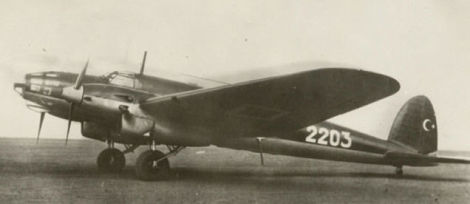
The Heinkel He 111 traces its development back to the early 1930s, when Ernst Heinkel, head of Heinkel Flugzeugwerke, was working on what he hoped would be the world’s fastest passenger plane. Two of his designers, the twin brothers Siegfried and Walter Günter, developed the Heinkel He 70 Blitz, a 4-passenger, single engine aircraft with elliptical wings, and the Blitz, as its name implies, was indeed fast and set numerous speed records. But in order to compete with American aircraft such as the Boeing 247 and Douglas DC-2, Heinkel needed a larger aircraft. So he had the Günter brothers develop a twin-engine version of the Blitz, which was called the Doppel-Blitz (Double Blitz). It was this aircraft that would serve as the basis for the wartime He 111. Development of the He 111 continued under civilian registrations, and the first prototype was recognized as “the fastest passenger aircraft in the world” when its speed exceed 250 mph. Ultimately, Lufthansa operated 12 He 111s on routes throughout Europe and even as far as South Africa.

Following the German design ethos of the time, the He 111 was powered by a pair of inverted, liquid-cooled engines, in this case the Junkers Jumo 211 V-12, which gave the bomber a top speed of 273 mph. In its military guise, defensive machine guns were mounted in the nose and in dorsal and ventral blisters, and up to 4,400 pounds of bombs could be carried internally. Using external hard points, nearly 8,000 pounds of bombs could be carried, but this made the 111 so heavy that it required rockets to assist with takeoff. Where the original doppel-blitz had a traditional stepped canopy, the later versions of the He 111 received the bullet-shaped glazed nose that made the bomber instantly recognizable.

The 111 flew its first combat missions during the Spanish Civil War (1936-1939), a conflict which served as a testing ground for Germany’s burgeoning air force and as a means of developing the tactics of combined operations of aircraft and ground troops. Flying in support of the fascist Nationalist government, the He 111 became famous (or infamous) for the bombing of the city of Guernica, one of the first times bombs were dropped on a defenseless civilian population. Based on experiences in Spain, and the ability of the He 111 to outrun all Spanish fighters of the time, Heinkel believed that the minimal defensive armament on the 111 would be sufficient in the looming war. However, during the Battle of Britain in 1940, the He 111 began to show its vulnerability. Though fast when it was first built, it was no match for the faster British fighters, nor was it very maneuverable. And its light defensive armament made it a relatively easy target for British guns.

But, with no new bomber to take its place, the He 111 soldiered on, and served throughout the war on all fronts, though it was essentially obsolete by 1942. Nevertheless, the He 111 was constantly upgraded and modified until production ended in 1944, and it proved to be an extremely versatile aircraft. The 111 served as a torpedo bomber, troop transport, reconnaissance aircraft, pathfinder (target marker), and glider tug. It was even modified to carry out aerial launches of the V-1 flying bomb. Ultimately, more than 6,500 civilian and military 111s were produced and, following the war, an upgraded version of the He 111 continued to be built under license in Spain as the CASA 2.111. Powered by Rolls-Royce Merlin engines, some of these aircraft operated into the early 1970s.

February 25, 1965 – The first flight of the McDonnell Douglas DC-9. The period following WWII was one of rapid technological development as piston engine technology began to give way to emerging jet engine technology. In 1952, the British manufacturer De Havilland was the first to produce a jet-powered airliner with the Comet, but other manufacturers clung to the proven radial engines of WWII. Others began to implement the turboprop engine, which was, in some ways, the best of both worlds. By the 1960s, de Havilland, Boeing and Douglas had all fielded large four-engine airliners powered by either turbojets or turbofans. Douglas’ entry into that category was the DC-8, which entered service in 1959 with Delta Air Lines and United Airlines.
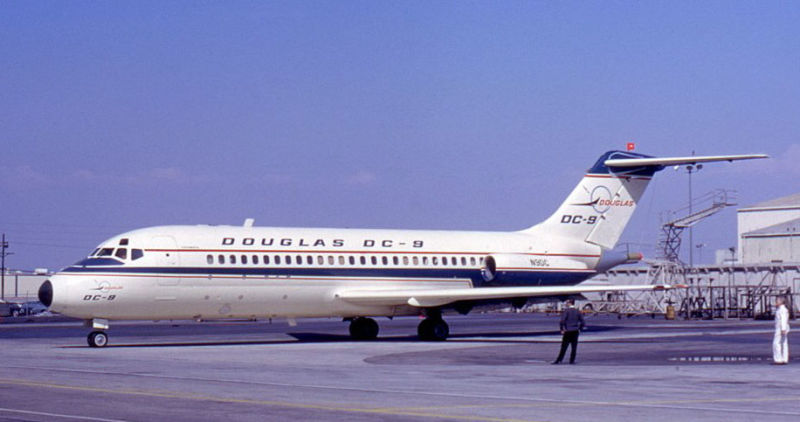
While the large four-engine airliners were efficient at hauling lots of passengers to far-flung destinations, the growth of the hub-and-spoke system meant that airlines needed smaller planes to bring passengers from the spokes into the hub. Douglas had already begun to investigate such an airliner with their Model 2067, which was basically a smaller version of the DC-8, but the airlines were not interested and Douglas dropped the idea. In 1960, Douglas entered into an agreement with Sud Aviation of France to sell and support the twin-engine Caravelle in the US, but when orders for the Caravelle didn’t materialize, Douglas decided to forge ahead on its own. Thus, it is likely no coincidence that, when the design of the DC-9 was finalized in 1962, it bore a strong resemblance to the Caravelle. The placement of the engines on the rear of the aircraft allowed for a clean, efficient wing which was better suited to reduced takeoff and landing speeds, and it also helped limit the ingestion of debris into the engines.

With the DC-8, Douglas had been slow to offer a stretched version of the airliner, a decision that hurt sales in their competition with the Boeing 707. That mistake was not repeated with the DC-9. Douglas planned from the beginning that the airliner would be the first in a series of aircraft, and they quickly followed the initial DC-9-10 with the successively larger -20, -30 and -40 variants, with the final -50 variant taking its maiden flight in 1974. With each successive variant, the airliner gained a longer fuselage, more seats, more powerful engines, and larger wings. The initial production version of the DC-9-10 was powered by a pair of Pratt & Whitney JT8D low-bypass turbofan engines and seated 90 passengers in a one class configuration. The -30, -40 and -50 variants saw passenger capacities increase to 115, 125, and 139 passengers respectively. The maximum takeoff weight (MTOW) of 82,000 lbs for the -10 was steadily increased to 121,000 lbs for the -50. But Douglas wasn’t done yet.

Following the -50 series, continued development of the DC-9 resulted in the McDonnell Douglas MD-80 and the MD-90 series (Douglas had merged with McDonnell in 1967) and, after McDonnell Douglas and Boeing merged in 1997, the Boeing 717, a variant that was closer in size to the earlier DC-9-30. Production of the DC-9 ended in 1982 after the completion of 976 airliners, but production of the entire series that started with the DC-9 ended in 2006 after 41 years with the final Boeing 717 delivered to AirTran Airways. In addition to its commercial service, the DC-9 was also flown by the US Air Force as a medical evacuation aircraft designated the C-9A Nightingale, and with the US Navy and Marine Corps as the C-9B Skytrain II. Delta Air Lines was the last major US carrier to retire the venerable DC-9 in 2014, and only a handful remain in service today. The MD-80 and MD-90 are starting to be phased out as well in favor of newer, more fuel-efficient airliners.

For plane spotters, it can be difficult to differentiate between the major variants of the series of twinjets that began with the DC-9. But there are some specific characteristics to aid in identification.
- DC-9 series: Short fuselage, no strakes under the cockpit, pointy tail. (The last DC-9 variant, the DC-9-50, was equipped with strakes, but it retained the cone-shaped tail.)
- MD-80 series: Longer fuselage, strakes under the cockpit, pinch tail, skinny engines.
- MD-90 series: Longer fuselage, strakes under the cockpit, pinch tail, fat engines.
- Boeing 717: Shorter body, no strakes under the cockpit, pinch tail, fat engines.
Basically, you can tell the DC-9 from the B717 by the tail cone, and the MD-80 series from the MD-90 series by the size of the engines.
Short Takeoff
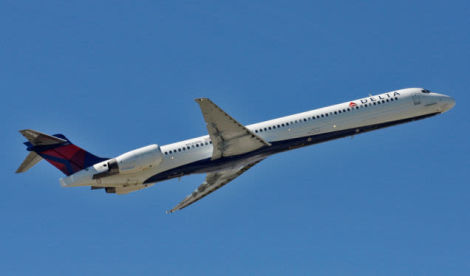
February 22, 1993 – The first flight of the McDonnell Douglas MD-90. Following the success of the McDonnell Douglas MD-80 series of airliners which were based on the earlier Douglas DC-9, the MD-90 was the next stage of the airliner’s development and featured a further stretched fuselage and more fuel-efficient engines. The MD-90 is five feet longer than the MD-88 and is powered by quieter International Aero Engines V2500 high-bypass turbofan engines which provide greater range and decreased fuel consumption. The flight deck was also updated with an electronic flight instrument system and LED displays. The MD-90 entered service in 1995 with Delta Air Lines and seats up to 172 passengers in a single-class configuration. Production of the MD-90 ended in 2000 after a total of 116 were built, with the last airliner delivered to Saudi Arabian Airlines.

February 22, 1978 – The launch of OPS 5111 (also known as Navstar-1), the first satellite in the Global Positioning System. The Global Positioning System (GPS) is made up of 24 satellites positioned in six Earth-centered orbital planes, each orbiting the Earth twice a day. Available in all weather conditions, the system provides geographic location within two meters and time information at any point on the Earth’s surface where there is unobstructed line of sight to any four satellites. GPS is based on the US military program called NAVSTAR (Navigation System Using Timing and Ranging) that was initially intended for military use only, but the system was opened to the public by President Ronald Reagan after Korean Air Lines Flight 007 was shot down by the Soviet Union in 1983 after the airliner strayed off course.
February 22, 1975 – The first flight of the Sukhoi Su-25, a close air support aircraft developed in the late 1960s to support Soviet ground forces. Inspired by the Ilushin Il-2 Sturmovik tank buster of WWII, the Su-25 (NATO reporting name Frogfoot) is analogous in mission to the Fairchild Republic A-10 Thunderbolt II and entered service in July 1981 during the Soviet invasion of Afghanistan. Armed with a single GSh-30-2 30mm cannon and capable of carrying 8,800 pounds of external stores, the Su-25 has seen action in many conflicts during its 35 years of service, including recent missions in support of the Assad regime in the Syrian Civil War. The Su-25 has been produced in numerous variants, including a two-seat trainer version, and has received continuous upgrades in avionics and weapons capabilities since its introduction. Over 1,000 have been built to date, and the Su-25 remains in production.
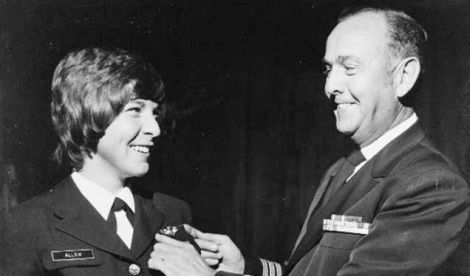
February 22, 1974 – US Navy LTJG Barbara Ann Allen becomes the first female aviator in the US Armed Forces and the first woman to be qualified as a military jet pilot. The first group of seven women entered US Naval Flight Training School on March 2, 1973 and Allen was the first in her class to be awarded her wings. She was first certified to fly the Grumman C-1 Trader, then became the first jet-qualified female pilot when she qualified to pilot the North American T-39 Sabreliner. After marrying, Allen (now Rainey) entered the Naval Reserves, where she qualified on the Douglas R6D (DC-6). Due to a shortage of instructor pilots, Rainey returned to active duty in 1977 as an instructor on the Beechcraft T-34 Mentor, but was killed in a training crash on July 13, 1982 while practicing touch-and-go landings with a student pilot.
February 22, 1954 – The first flight of the Convair R3Y Tradewind, a turboprop-powered flying boat developed by Convair to take advantage of postwar advances in aircraft construction and engine technologies. The Tradewind featured a laminar flow wing and was powered by four Allison T-40 turboprops turning six-bladed contra-rotating propellers. With a hinged nose that allowed loading of large cargo, the Tradewind served as a strategic airlifter and performed transport duties for the US Navy. Six aircraft were converted to aerial tankers as the R3Y-2 and were capable of refueling four aircraft at once. Only 13 Tradewinds were built, and the program was canceled after continued problems with the Allison engines led to a number of fatal crashes caused by engine failure. All the remaining aircraft were grounded in 1958 and eventually scrapped.
February 22, 1925 – The first flight of the de Havilland DH.60 Moth, a two-seat touring and training biplane developed by Geoffrey de Havilland from the larger, three-seat de Havilland DH.51 biplane. The DH.60 was the first in a long line of derivative aircraft and was operated extensively by British flying clubs, a popularity due in large part to its folding wings which allowed the Moth to be stored in smaller hangars. The Moth also served as a military trainer, with the RAF eventually flying a total of 124 DH.60M (Metal Moth) variants that featured a metal fuselage. The Moth was widely exported to foreign air forces, where it served as a primary flight trainer in 31 countries. With the addition of a more powerful de Havilland Gipsy 4-cylinder engine, it became known as the Gipsy Moth, and others were fitted with floats for use as a seaplane.

February 23, 2008 – A Northrop Grumman B-2 Spirit bomber crashes at Andersen Air Force Base in Guam. The B-2 Spirit belonging to the 393rd Bomb Squadron, 509th Bomb Wing based at Whiteman Air Force Base in Missouri experienced an uncommanded 30-degree nose-high pitch up during takeoff which led to the stall and crash of the $1.4 billion bomber. Both crew members ejected; the pilot was uninjured, but the co-pilot suffered a spinal compression fracture from the ejection. The cause of the crash was traced to moisture that had collected in the air data sensors following a night of heavy rain which gave the flight computer incorrect altitude and windspeed data. It remains the only crash of the B-2 bomber, and the most expensive write off in the history of the US Air Force. Video of the crash can be seen here.
February 23, 1951 – The first flight of the Dassault Mystère, a fighter-bomber built by the French firm Dassault as a swept-wing development of the earlier Dassault Ouragan. Prototypes of the Mystère were powered by an upgraded Rolls-Royce Tay centrifugal-flow turbojet in place of the Ouragan’s Rolls-Royce Nene, while production models of the Mystère were powered by a SNECMA Atar 101 axial-flow turbojet. Armed with two 30mm cannons, rocket pods, and up to 2,000 pounds of bombs, the Mystère entered service with the French Air Force in 1954, though it never saw combat. Nevertheless, the Mystère was an important step in the development of modern French jet fighters.
February 23, 1934 – The first flight of the Lockheed Model 10 Electra. Lockheed’s first twin-engine, all-metal monoplane airliner was developed from the single engine Lockheed Model 9 Orion to compete with the Boeing 247 and Douglas DC-2. The Model 10 suffered from early problems with stability which were eventually solved by a brilliant young engineer named Clarence “Kelly” Johnson, who would go on to head Lockheed’s famous Skunk Works. Following the US ban on single-engine passenger aircraft, the Electra became one of the more popular new aircraft with the budding airline industry. Many Electras were also flown by private pilots, including Amelia Earhart. Earhart was flying an Electra when she disappeared during her attempt to circumnavigate the globe. A total of 149 Model 10s were produced.

February 24, 1989 – The forward cargo door blows off of United Airlines Flight 811 in flight. UAL 811 was a regularly scheduled Boeing 747 flight that took off from Honolulu, Hawaii bound for Auckland, New Zealand. While climbing to cruising altitude and passing between 22,000 and 23,000 feet, the forward cargo hatch blew off after it was closed improperly by the ground crew. As the door departed the aircraft, it took a large section of the cabin wall with it, and the ensuing explosive decompression caused the floor to buckle and sucked ten seats and eight passengers out of the aircraft. An investigation found that damaged locking pins gave a false reading of the door’s being shut properly. Both United and the ground crew were faulted, and Boeing subsequently redesigned the locking mechanism.

February 24, 1955 – The first flight of the CIM-10 BOMARC missile, a long-range supersonic surface-to-air missile fielded by the United States during the Cold War for the defense of North America against attacking nuclear bombers. The BOMARC (an acronym of Boeing and Michigan Aerospace Research Center) had an operational radius of 200 miles, was designed to fly at Mach 2.5-2.8 at 60,000 feet, and could be armed with either a conventional or nuclear warhead. The USAF ultimately set up 16 BOMARC sites armed with 56 missiles each. With the arrival of the intercontinental ballistic missiles, attacking bombers were no longer perceived as a threat, and the BOMARC was retired in 1972.
February 25, 1990 – Smoking is banned on all US domestic flights. Consumer protection advocate Ralph Nader was the first to call for a smoking ban on US airlines, and United Airlines was the first to implement a separate smoking section on their airliners in 1971. By April 1988, a smoking ban was instituted on flights of two hours or less and, by 1990, smoking was banned on all domestic flights of six hours or less. Ten years later, the ban was further extended to all domestic and international flights. Smokers who violate the ban face a fine of up to $500 or 10 days in prison. Initially, pilots were allowed to continue smoking on the flight deck due to safety concerns over the effects of nicotine withdrawal in chronic smokers, though the FAA extended the smoking ban to the flight deck in 1992. The use of E-cigarettes or vaping devices is also prohibited.

February 25, 1978 – The death of Daniel “Chappie” James, Jr, a USAF fighter pilot and the first African American to attain the rank of four-star general. James served as a flight instructor for the 99th Pursuit Squadron of the Tuskegee Airmen, but saw no combat in WWII. In Korea, James flew 101 combat missions in the North American P-51 Mustang and Lockheed F-80 Shooting Star, and then flew 78 combat missions in Vietnam. Most of those missions were in the dangerous areas of Hanoi and Haiphong Harbor, and James led one mission in which pilots claimed seven MiG-21 kills, the highest for a single sortie in the war. After achieving the rank of General, James was named commander in chief of NORAD, where he held operational command of all strategic aerospace defenses of the US and Canada. James died of a heart attack on February 25, 1978, just three weeks after his retirement from the US Air Force.
February 25, 1963 – The first flight of the Transall C-160, a twin-turboprop military transport and cargo aircraft developed as a joint venture between Germany and France. “Transall” is an acronym for Transporter Allianz, and the C-160 was developed to satisfy requirements that arose in the late 1950s for a new transport aircraft to replace the Nord Noratlas. The Transall consortium was formed in 1959 and, following a delay in production while Lockheed unsuccessfully marketed the Lockheed C-130 Hercules to Germany, the first production aircraft were delivered in 1967. A total of 214 were built between 1965-1985, and the C-160 has since become one of a handful of aircraft to see over 50 years of service.
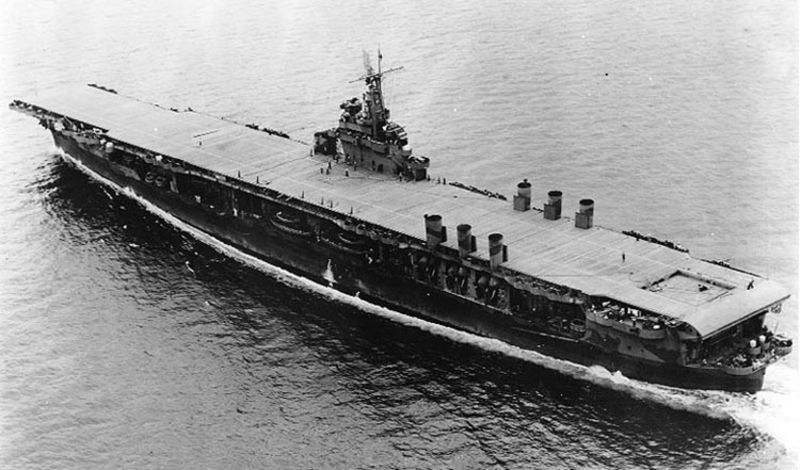
February 25, 1933 – The launch of the USS Ranger (CV-4), the first US Navy ship to be designed from the keel up as an aircraft carrier. Similar to the Navy’s first carrier, USS Langley (CV 1), which had been converted from a collier, Ranger was not designed with an island superstructure, though one was added later. Unable to keep pace with more modern carriers plying the Pacific Ocean, Ranger served in the Atlantic and provided air support for the landings in North Africa during Operation Torch in November 1942. In 1943, Ranger participated in raids against German shipping in the North Atlantic as part of Operation Leader, and served as a training carrier late in the war. Ranger decommissioned in 1946 and scrapped the following year.
Connecting Flights
If you enjoy these Aviation History posts, please let me know in the comments. You can find more posts about aviation history, aviators, and aviation oddities at Wingspan.
